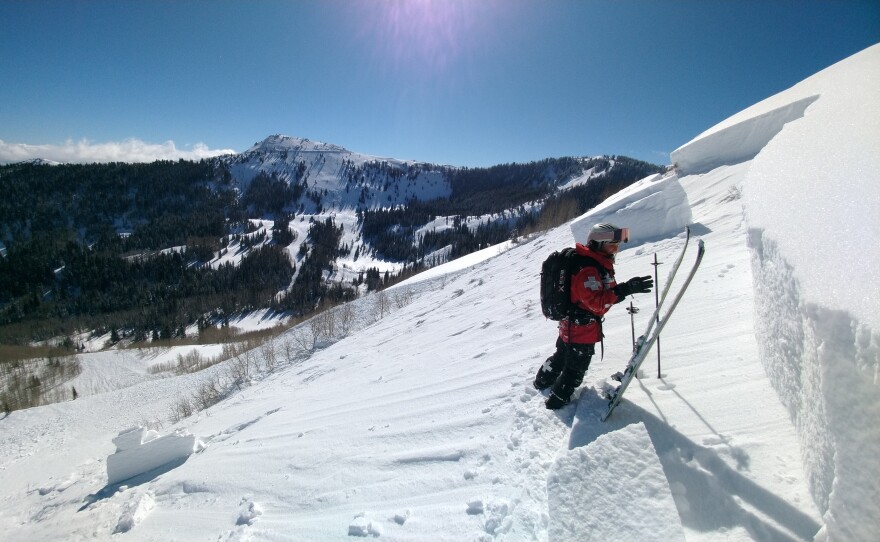On Tuesday, the Summit County Sheriff’s Office reported an avalanche in the Dutch Draw area of The Canyons side of Park City Mountain, between the lifts Peak Five and Ninety-Nine 90.
According to Andy Van Houten, snow safety director of Park City Mountain, the avalanche occurred in the back country.
"We worked with the Department of Public Safety helicopter," he said. "We're able to establish that nobody was involved. We had all of our witnesses accounted for, all is good.”

Van Houten is in high demand on the mountain. He has worked in avalanche control for 20 years and said an avalanche like the one on Tuesday is an example of what happens in places where there is no avalanche mitigation; it can be life-threatening for backcountry snow enthusiasts.
“We don't do any mitigation outside of the resort and so it's 100% on the on the user, on themselves; we do worry about it from a rescue perspective but we do not do anything to mitigate that hazard," he said.
Van Houten’s team goes to work while most people are asleep to assess avalanche danger.
“Our crews start showing up right around 3 a.m. or 3:30 in the morning, we start gathering snow info, weather info, making a plan, we have to start assembling explosives,” Van Houten said. “And then generally the rest of majority of our crew that's coming in to perform the work shows up around 5:30 a.m., we load lifts by six, generally our kind of earliest we get out is sunlight, it's at first light. And so it's usually right around 7 a.m. depending on the time of the year.”
In the early part of the season, Van Houten said they do avalanche control work eight to 10 hours a day because conditions dictate more explosives. He said it’s not unusual to hear a shot go off around 4 p.m. or 5 p.m.
There are a few ways to reduce avalanche risks. One is ski cutting, where a patroller will ski intentionally fast from the top of the slope on the right-hand side diagonally across to the left side. This will trigger an avalanche as the slope is traversed. This method is used on smaller slides; for the bigger ones they bring in the explosives.

Van Houten said there is a team of mitigators who go out in groups of two or three and carry explosives in their backpacks.
“It’s a cast booster, it's about the size of a large can of soup and it's a pentolite TNT combination," he said. "It's got 120-second fuse strain on it. It's basically like a little cardboard tube and that's it's got a sparker in it. And when we pull that, that's what ignites the end of the fuse train. And so it's basically then we either rope them, or we just throw them. And it's like throwing a can of soup into the snowpack. It's, it's a good, it's a good-sized shot. But we are usually pretty far away when it detonates and we kind of plug our ears and kind of turn our backs to it a little bit. So we're not we're not close to it by any means.”
An avalanche can occur anywhere there is a slope and snow, in other words, anywhere in the resort. He said slope angle is one of the big variables.
“And primarily, avalanches can occur anywhere from like 35 to 45 degrees with kind of 38 degrees being the bullseye number there," he said. "If you think about that, in relation to a ski slope, that's generally like a good blue or black groomed run and so those are where folks want to ski and those are the primary focuses for us.”
Van Houten said the last form of mitigation is called skier compaction.
“The best thing we can do is get this terrain open to public and get it skied,” he said. “That's why we push so hard to get this terrain open, you know, in a timely fashion is that so we can get our guests up there to ski it and that's what helps us, that kind of skis all the snow and it breaks up the layers that build up.”
Chris Erkkila, ski patrol manager for Deer Valley, told KPCW the majority of explosives are used in the Empire Canyon area, specifically Daly Bowl and Daly Chutes. He said the patrol teams also use explosives in the Sultan, Mayflower and Lady Morgan areas.
Erkkila said Deer Valley does explosives work early in the morning in order to finish by the time first chair rolls around. They also use ski cutting as a mitigation technique. He said he’s seen both methods release all sizes of avalanches.






